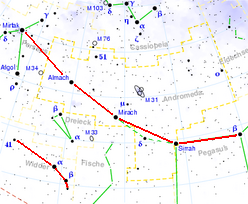Star array
In older astronomy, a star row is a line-like structure of three or more fixed stars that are closely adjacent in the starry sky or are relatively evenly spaced. Such sequences shape the shape of many constellations , for example the snake and water snake , the dragon , the river Eridanus or the scorpion .
A very well-known series of stars is the Orion Belt with three equally spaced bright stars that do not exist in this form a second time in the sky. They also point to the brightest fixed star in the entire starry sky, Sirius . Only five degrees below you can see another (weaker) row of stars, the so-called "sword hanger". It consists of three clearly visible stars, the middle of which turns out to be the well-known Orion Nebula in binoculars .
In the vicinity of the shimmering band of the Milky Way there are more freely visible star rows than outside, which is due to the higher star density. Some star rows are particularly noticeable in the winter sky . To what extent they go beyond a random probability has not yet been clearly analyzed.
On clear autumn evenings, the five-star row of five stars of the 2nd magnitude rising up in the east can be seen. The elongated, regular series of stars, to which Widmann / Schütte ascribe the character of a separate constellation, begins in Perseus , contains three stars from Andromeda and ends in Pegasus .
About 15 ° to the south, the constellation Aries forms a constellation that represents a flat, open logarithmic spiral : four stars, the distance between which is halved and whose connecting lines turn further and further to the right (see picture).
More star rows or star chains
Among the other about 20 freiäugig visible star rows of the sky are still the arrow (3-4 stars), the longitudinal axis of the swan (five stars) and the top five stars of the Big Dipper emphasized. The latter are not arranged quite regularly, but are among the 30 brightest stars in the northern sky with the exception of the middle one.
Even in detail - for example when observing star clusters with a telescope - there are surprisingly many rows of stars, which could be related to the formation of stars in groups . Related investigations of open star clusters took u. a. Wilhelm Schur in the constellation Perseus ; Newer works such as Feiler / Noack also emphasize such striking constellations in around 30 of the Messier objects, which can already be clearly seen in amateur telescopes. Some well-resolvable globular clusters also show such structures [see Stoyan 2006], and others. a. M12 and M13 .
literature
- H. Kraemer, W. Foerster: Universe and humanity. Volume III, Berlin / Leipzig / Vienna 1902, pp. 12f, 30f, 55ff, 270ff.
- Widmann, Schütte : Which star is that? Kosmos-Verlag 1958.
- D. Block: Astronomy as a hobby. Bassermann, Munich / Těsín 2005.
- AW Schur : Measurement of the two star clusters h and chi Persei. Goettingen 1900.
- M. Feiler, P. Noack: Deep Sky Travel Atlas. 2nd Edition. Oculum-Verlag 2005
- Ronald Stoyan : Atlas of the Messier Objects - The Highlights of the Deep Sky , p. 92-93. Oculum-Verlag, Erlangen 2006.
